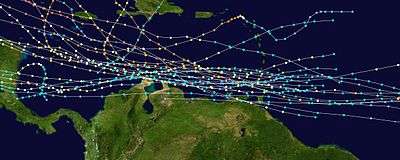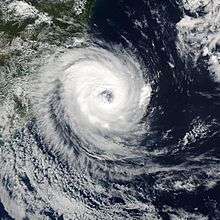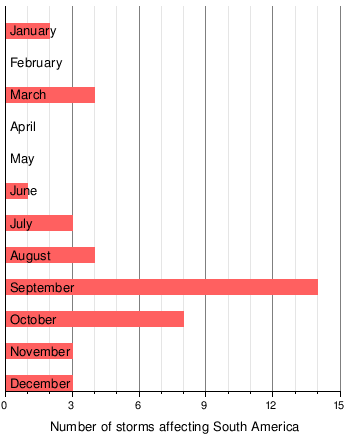List of South America tropical cyclones

A South American cyclone is a tropical cyclone that affects the continent of South America or its countries. The continent is rarely affected by tropical cyclones, though most storms to hit the area are formed in the North Atlantic Ocean. Typically, strong upper level winds and its proximity to the equator prevents North Atlantic impacts.[1] No tropical cyclone has ever affected the Pacific side of South America. Although conditions are typically too hostile for many storms to hit the area from the South Atlantic Ocean, there have been a few tropical cyclones to affect land. Based on climatology, northern Venezuela and Colombia have a 1 to 5% chance of a hurricane strike in any given year, while all locations south of 10° N have less than a 1% chance of a direct hit.[2] A total of 38 tropical cyclones have affected the continent since 1588.
Storms in the South Atlantic
The South Atlantic Ocean is generally inhospitable to the formation of a tropical storm. Although rare, a growing number of subtropical cyclones have developed in the South Atlantic Ocean near Brazil, such as the unofficially-named Hurricane Catarina of 2004 that made landfall as a Category 2 on the Saffir-Simpson hurricane wind scale. Since 2011, certain storms have official names, such as Subtropical Storm Arani. At least one storm has formed near the West Coast of Africa.
List of tropical cyclones
Pre-1900
- November 4–6, 1588 - Cartagena de Indias in Colombia is affected by a hurricane.[3]
- September, 1672 - A hurricane affects Caracas, Venezuela.[3]
- October 22, 1683 - The island of Curaçao off Venezuela is impacted by a hurricane.[3]
- September, 1773 - A hurricane moves across Venezuela[4] and later Colombia.[3]
- December 13–22, 1822 - A hurricane traverses the southeastern Caribbean Sea and makes landfall on Venezuela.[4]
- October 13, 1847 - Venezuela is affected by a hurricane.[4]
- September 23, 1877 - A 105 mph (170 km/h) Category 2 hurricane makes landfall on northern Venezuela, causing winds of up to 80 mph (130 km/h) in Curaçao.[5]
- September 17, 1886 - A Category 2 hurricane parallels the north coast of Venezuela, causing winds of up to 40 mph (65 km/h) in Curaçao.[6]
- December 10, 1887 - A tropical storm passes just north of the Guajira Department of Colombia.[7]
- October 8, 1892 - A Category 2 hurricane hits Northern Venezuela and Colombia,[8] causing rough seas in Curaçao.[9]
1900s
.jpg)
- September 5, 1911 - Curaçao experiences a westward moving tropical storm which passes near the northern coasts of Venezuela and Colombia.[10]
- November 2–5, 1932 - A Category 2 hurricane parallels the north coast of Venezuela and Colombia 75 miles (120 km) offshore, causing some damage. Later, it passes to the northeast of Providencia Island, destroying 36 houses and ruining crops.[11]
- June 27, 1933 - A minimal hurricane moves through northeastern Venezuela. The hurricane destroys several houses, businesses, and fishing boats. Powerful winds cut telephonic and telegraphic communications for several days. The hurricane killed several people, and caused over $200,000 in damage (1933 USD, $3.3 million 2008 USD).[12]
- October 8, 1954 - Hurricane Hazel parallels the north coasts of Venezuela and Colombia around 100 miles (160 km) offshore as a Category 3 hurricane, though effects, if any, are unknown.[13]
- September 25, 1955 - Hurricane Janet parallels the north coasts of Venezuela and Colombia around 100 miles (160 km) offshore as a Category 4 hurricane, though effects, if any, are unknown.[14]
- July 20, 1961 - Hurricane Anna passes 75 miles (120 km) north of the coast of Venezuela, though effects, if any, are unknown.[15]
- October 1, 1963 - Hurricane Flora strikes Tobago and remains just offshore of Venezuela as it moves through the Caribbean Sea as a Category 3 hurricane. Damage in Venezuela, if any, is unknown.[16]
- September 7, 1971 - A tropical depression intensifies into Tropical Storm Edith near the north coast of Venezuela. The southern portion of the depression's circulation moves over the northeastern portion of the country.[17] Effects are unknown.
- September 16, 1971 - A tropical depression that later becomes Hurricane Irene crosses the island of Curaçao. Effects are unknown.[18]
- August 14, 1974 - Tropical Storm Alma makes landfall on northeastern Venezuela and later dissipates over the mountainous country. Intense rain bands cause a passenger plane to crash on Isla Margarita, resulting in 47 indirect deaths. Damage is unknown.[19]
- August 12, 1978 - Tropical Depression Cora dissipates near the island of Curaçao, causing no known impact.[20]
- September 13, 1978 - A tropical depression that later becomes Hurricane Greta forms near the northeastern coast of Venezuela, causing no known damage.[20]
- September 10–12, 1988 - Outflow bands from Hurricane Gilbert produce flash flooding in northern Venezuela. The flooding killed five people.[21]
- October 16–18, 1988 - Tropical Storm Joan strikes northern Venezuela and Colombia. The storm produces flash flooding which kills 11 in Venezuela. In Colombia, rainfall from Joan kills 25, and leaves 27,000 homeless.[22]
- August 14, 1990 - Minimal Tropical Storm Fran dissipates over northeastern Venezuela, with no known impact.[23]
- August 7–9, 1993 - Tropical Storm Bret moves across northern Venezuela and Colombia. In Venezuela, the storm drops at least 13.35 inches (339 mm) in Guanare. The rainfall causes mudslides, particularly near the city of Caracas, that cover many low-income housing units. Of the 173 deaths caused by Bret in Venezuela, most occur in the low-income areas near Caracas.[24] Lack of preparation, including weather forecasters prematurely stating the worst of the storm is over, is part of the problem.[25] In all, 10,000 are left homeless, and damaged totals $25 million (1993 USD, $37 million 2008 USD). In Colombia, Bret causes one death and one injury.[24]
- July 24–27, 1996 - Hurricane Cesar moves westward across the southern Caribbean Sea and crosses over extreme northern Colombia and the San Andrés archipelago. Cesar kills 11 people in Colombia due to flooding and mudslides.[26]
- November 13–16, 1999 - Strong waves from Hurricane Lenny affect the Guajira Peninsula of Colombia, flooding 1,200 homes and businesses along the northern coastline. In addition, winds and rains from the hurricane causes severe crop damage in the country.[27] The hurricane kills two in Colombia.[28]
2000s

- September 25, 2000 - Hurricane Joyce dissipates just north of eastern Venezuela, causing no known damage.[29]
- September 14, 2002 - Hurricane Isidore crosses over northeastern Venezuela as a tropical depression. Effects, if any, are unknown.[30]
- December 4, 2003 - Tropical Storm Odette produces heavy rainfall of up to 8 inches (200 mm) in Colombia.[31]
- January 20, 2004 - A possible tropical storm or depression in the South Atlantic Ocean hits eastern Brazil, dropping heavy rainfall in the area.[32]
- March 28, 2004 - A cyclone, unofficially named Hurricane Catarina, strikes southeastern Brazil with maximum recorded winds of 90 mph (145 km/h).[33] The hurricane damaged more than 30,000 homes and left 1,900 people homeless. The storm also damaged 1,373 businesses and destroyed 50, including a hospital. The storm killed 3, injured 38,[34] and caused up to $330 million in damage (2004 USD).[33]
- September 7–9, 2004 - Hurricane Ivan parallels the north coast of Venezuela as a Category 4 hurricane. Ivan's strong winds forced the closure of several airports. The hurricane also produced heavy rainfall and strong waves.[35] Ivan killed three in the country,[36] though overall damage was minor.[37]
- July 14, 2005 - Hurricane Emily passes just north of Venezuela as a strengthening hurricane, causing heavy rains and flooding in the northeastern portion of the country. 64 families were forced to leave their homes when rivers in eastern Monagas state overflowed their banks, but waters quickly receded. Ships were forced to remain at port while the hurricane passed to the country's north, though restrictions quickly lifted.[38]
- October 29, 2005 - Hurricane Beta hits the Colombian island of Providencia, and tears the roofs off of thousands of homes. High winds also shut down all airports and communications.[39]
- September 2, 2007 - Strong winds and waves from Hurricane Felix leave one person missing in the coastal Venezuelan city of Puerto Cabello.[40]
- January 28, 2009 - A cold-core mid to upper-level trough in phase with a low-level warm-core low formed a system over Uruguay and Rio Grande do Sul state in Brazil and moved eastward into the South Atlantic. The system was eventually classified as a subtropical cyclone, making it the only subtropical cyclone on record to effect South America, and the second subtropical system ever recorded in the South Atlantic, with the first being a subtropical cyclone in 1974. Winds exceeded 54 knots (100 km/h; 62 mph) on the coast of Uruguay and extreme southern Rio Grande do Sul, and the system produced 300 mm (12 in) of rainfall or more in 24 hours in some locations of Rocha (Uruguay) and southern Rio Grande do Sul. Fourteen deaths and thousands of evacuees are attributed to the storm with an emergency declared in four cities.
- March 10, 2010 - Unofficially named (by private and public weather centers from Southern Brazil) Tropical Storm Anita (90Q) affected the coast of southern Brazil. The cyclone develops out of a subtropical cyclone and is one of the rare tropical cyclones developed in South Atlantic Ocean waters.
- Early November 2010 - Tropical Storm Tomas brings heavy rains to Curaçao and South America.
- March 10, 2011 - Before becoming a subtropical cyclone, Subtropical Storm Arani produces torrential rains over Brazil. Damage is unknown.
- March 10–13, 2015 - Subtropical Storm Cari stalls offshore Brazil, dropping up to 6 in (150 mm) of rain, strong waves, and strong winds.
- September 30, 2016 - Hurricane Matthew affected the coast of Venezuela with tropical storm force winds. One person died in Aribia in Colombia due to flooding.
Listed by month
39 tropical cyclones have affected South America in most months of the year.
|
 |
Deadliest storms
Data from South American tropical cyclones is sparse and incomplete, though most tropical cyclones that struck the continent caused multiple deaths. Bret, Joan, Cesar, Gilbert, Catarina, and Ivan all caused their deaths through rainfall or flash flooding.
| Name | Year | Number of deaths |
|---|---|---|
| Bret | 1993 | 174 |
| Joan | 1988 | 36 |
| Subtropical Cyclone of January 2009 | 2009 | 14 |
| Cesar | 1996 | 11 |
| Gilbert | 1988 | 5 |
| "Catarina" | 2004 | 3 |
| Ivan | 2004 | 3 |
| Lenny | 1999 | 2 |
| Hattie | 1961 | 1 |
| Matthew | 2016 | 1 |
| Two | 1933 | "Several" |
| Alma | 1974 | 0 (47 indirect) |
Tropical cyclone warnings and watches
In the event an Atlantic hurricane threatens the northern coast of South America, the National Hurricane Center defines nine locations as tropical cyclone warning breakpoints. The westernmost is the border between Panama and Colombia, and the easternmost is Georgetown, Guyana, located at 6.82° N. In the eastern Pacific Ocean, tropical cyclone warning breakpoints extend eastward to the border of Panama and Colombia at 7.23° N.[41] No Atlantic hurricane has existed south of 6.82° N,[42] and no Pacific hurricane has existed east of 80° W,[43] though in the event a tropical cyclone threatens a region of South America without warnings, additional warning sites can be selected. In addition to warnings on the mainland of South America, the National Hurricane Center defines the entire island of San Andres as a tropical cyclone warning breakpoint.[41]
Intense Hurricane Flora in 1963 prompted officials to declare gale warnings for two islands off the north coast of Venezuela.[44] In 1974, the passage of Tropical Storm Alma warranted the issuance of Gale Warnings for the Paria and Paraguaná Peninsulas.[19] Hurricane Joan in 1988, Tropical Storm Bret in 1993, Hurricane Cesar in 1996, and Hurricane Felix in 2007 resulted in tropical storm and hurricane watches and warnings for several locations in South America.[45][46][47][48] The threat of Hurricane Ivan prompted a hurricane watch and a tropical storm warning for the northern coast of Venezuela.[49]
See also
- South Atlantic tropical cyclone
- List of Atlantic hurricane seasons
- List of Atlantic hurricanes
- Tropical cyclone
- Effects of Hurricane Ivan in the Lesser Antilles and South America
References
- ↑ "Ask Tom Why". WGN9 Chicago. 2004. Archived from the original on 2006-04-27. Retrieved 2006-07-20.
- ↑ Pielke, Rubiera, Landsea, Fernández, and Klein (2003). "Hurricane Vulnerability in Latin America & The Caribbean" (PDF). National Hazards Review. Retrieved 2006-07-20.
- 1 2 3 4 Ricardo Garcia-Herrera, Luis Gimeno, Pedro Ribera and Emiliano Hernandez. "New records of Atlantic hurricanes from Spanish documentary sources". Retrieved 2006-07-20.
- 1 2 3 Michael Chenoweth (2006). "A Reassessment of Historical Atlantic Tropical Cyclone Activity, 1700-1855" (PDF). Retrieved 2006-07-20.
- ↑ NOAA (2005). "1877 Atlantic hurricane season". Retrieved 2006-07-20.
- ↑ NOAA (2005). "1886 Atlantic hurricane season". Retrieved 2006-07-20.
- ↑ NOAA (2005). "1887 Atlantic hurricane season". Retrieved 2006-07-20.
- ↑ NOAA (2005). "1892 Atlantic hurricane season". Retrieved 2006-07-20.
- ↑ National Weather Service (1892). "1892 Monthly Weather Review" (PDF). Retrieved 2006-07-21.
- ↑ NOAA (2005). "1911 Atlantic hurricane season". Retrieved 2006-07-21.
- ↑ National Weather Service (1932). "1932 Monthly Weather Review" (PDF). Retrieved 2006-07-21.
- ↑ National Weather Service (1933). "1933 Monthly Weather Review" (PDF). Retrieved 2006-07-21.
- ↑ National Weather Service (1954). "1954 Monthly Weather Review" (PDF). Retrieved 2006-07-21.
- ↑ National Weather Service (1955). "1955 Monthly Weather Review" (PDF). Retrieved 2006-07-21.
- ↑ National Weather Service (1961). "1961 Monthly Weather Review" (PDF). Retrieved 2006-07-21.
- ↑ National Weather Service (1963). "1963 Monthly Weather Review" (PDF). Retrieved 2006-07-21.
- ↑ John Hope (1971). "Hurricane Edith Preliminary Report Page 1". National Hurricane Center. Retrieved 2006-11-01.
- ↑ National Weather Service (1971). "1971 Monthly Weather Review" (PDF). Retrieved 2006-07-21.
- 1 2 National Hurricane Center (1974). "Tropical Storm Alma Tropical Cyclone Report". Retrieved 2006-11-18.
- 1 2 National Weather Service (1978). "1978 Monthly Weather Review" (PDF). Retrieved 2006-07-21.
- ↑ National Weather Service (1988). "1988 Monthly Weather Review" (PDF). Retrieved 2006-07-21.
- ↑ Dr. Harold P. Gerrish (1988). "Hurricane Joan Tropical Cyclone Report Page 3". National Hurricane Center. Retrieved 2006-07-21.
- ↑ National Hurricane Center (1990). "Tropical Storm Fran Tropical Cyclone Report". Retrieved 2006-07-21.
- 1 2 National Weather Service (1993). "1993 Monthly Weather Review" (PDF). Retrieved 2006-07-21.
- ↑ John Wade (1993). "Catastrophe in Caracas". The Herald. Retrieved 2006-07-21.
- ↑ Associated Press (1996). "Hurricane Douglas leaves at least 35 dead as it crosses from Caribbean to Pacific". Retrieved 2006-07-21.
- ↑ Agence France-Presse (1999). "One death blamed on Hurricane Lenny; still threatens Caribbean". Retrieved 2006-07-21.
- ↑ John L. Guiney (1999). "Hurricane Lenny Tropical Cyclone Report". National Hurricane Center. Retrieved 2006-07-21.
- ↑ Miles B. Lawrence (2000). "Hurricane Joyce Tropical Cyclone Report". National Hurricane Center. Retrieved 2006-07-21.
- ↑ Lixion A. Avila (2002). "Hurricane Isidore Tropical Cyclone Report". National Hurricane Center. Retrieved 2006-07-21.
- ↑ World Meteorological Organization (2004). "Final Report of the 2003 Atlantic Hurricane Season" (PDF). Archived from the original (PDF) on October 29, 2005. Retrieved 2006-07-21.
- ↑ Gary Padgett (2004). "January 2004 Tropical cyclone summary". Archived from the original on 2006-06-16. Retrieved 2006-07-21.
- 1 2 D. H. Levinson (2004). "State of the Climate in 2004". American Meteorological Society. Retrieved 2006-07-21.
- ↑ Associated Press (2004-03-30). "First South Atlantic hurricane hits Brazil". USA Today. Retrieved 2006-07-21.
- ↑ Agence France-Presse (2004). "Hurricane Ivan kills at least 14 in Caribbean". Retrieved 2006-07-21.
- ↑ Stacy R. Stewart (2004). "Hurricane Ivan Tropical Cyclone Report". National Hurricane Center. Retrieved 2006-07-21.
- ↑ International Federation of the Red Cross (2004). "Caribbean:Hurricane Ivan" (PDF). Retrieved 2006-07-21.
- ↑ News from Russia (2005). "Emily passed Venezuela". Retrieved 2006-07-21.
- ↑ Adventist News Network (2005). "Colombia: Adventists Aid Hurricane Beta Relief Effort on Tiny Island". Archived from the original on March 10, 2012. Retrieved 2010-09-26.
- ↑ Agence French-Presse (2007). "Maximum strength Hurricane Felix aims for Central America". Retrieved 2007-09-03.
- 1 2 National Hurricane Center (2006). "Hurricane and Tropical Storm Watch/Warning Breakpoints". Archived from the original on July 8, 2007. Retrieved 2006-11-18.
- ↑ Hurricane Research Division (2006). "Hurdat Data for Tropical Cyclones 1851-2005". NOAA. Archived from the original on 2006-07-05. Retrieved 2006-11-18.
- ↑ Hurricane Research Division (2006). "Hurricane Data for Pacific Hurricanes 1949-2005". NOAA. Archived from the original on 2006-06-14. Retrieved 2006-11-18.
- ↑ Hoose (1963). "Hurricane Flora Advisory 4". San Juan Weather Bureau. Retrieved 2006-11-18.
- ↑ NHC (1988). "Hurricane Joan Tropical Cyclone Report Page 8". Retrieved 2006-11-18.
- ↑ NHC (1993). "Tropical Storm Bret Tropical Cyclone Report Page 10". Retrieved 2006-11-18.
- ↑ Avila (1996). "Hurricane Cesar Tropical Cyclone Report". NHC. Retrieved 2006-11-18.
- ↑ Blake & Avila (2007). "Tropical Depression Six Public Advisory One". NHC. Retrieved 2007-09-03.
- ↑ Stewart (2004). "Hurricane Ivan Tropical Cyclone Report". NHC. Retrieved 2006-11-18.